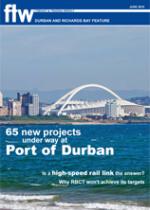The Gautrain high speed
commuter train that went into
service between OR Tambo
International Airport and Sandton
during June appears to have become
the catalyst for a move aimed at
converting South Africa’s extensive
Cape gauge (1067mm) railway
network into the wider European
standard gauge (1435mm).
In so doing it has also drawn
attention to fundamental differences
between the policy makers of
the Department of Transport and
the operational requirements of
Transnet, which despite being a
transport company falls under the
umbrella of a separate government
department, Public Enterprises.
The mood for building new
railways to the standard gauge is
one that is sweeping across much
of Africa, where a legacy exists of
laying the blame for 50 and more
years of neglect of state-owned
railways at the foot of the former
colonial powers who now stand
accused of introducing a cheaper
railway system simply because it
was for Africa and therefore didn’t
matter.
These are arguments that have
been used in countries as far apart as
Nigeria, Kenya, Uganda, Tanzania
and now in South Africa, and which
serve to cloud some of the real
issues at stake. With the support of
European ‘advisers’ and advice from
bodies such as the World Bank and
other funding agencies, a number
of African countries appear to have
embarked on a course of uprooting
existing railway networks and
replacing them at crippling cost
with what is claimed to be a
superior system.
In South Africa the indications of
clear disagreement between Transnet
and the Department of Transport
came to the fore when Transnet was
accused by a parliamentary transport
committee of not sharing the same
vision for South Africa’s
R750 billion infrastructure plan.
On the other hand the Minister
of Transport, S’Bu Ndebele, has
firmly nailed his colours to the mast
by indicating his desire for a new
standard gauge railway between
Durban and Gauteng, capable of
carrying passengers at high speed
between the two metropolitan areas
at speeds in excess of 160 km/h.
Ndebele believes this will become
the catalyst needed to remove freight
traffic from the roads.
The minister said in April that he
would seek cabinet approval for a
feasibility study during the current
fiscal year. He claimed that a high
speed railway would encourage the
movement of freight off the roads
and onto rail along the country’s
most congested traffic route and said
that a Johannesburg to Cape Town
standard gauge link should also
be considered.
His comments preceded the
revelation that road maintenance
in South Africa faced a R75 billion
backlog.
A somewhat differing view comes
from Transnet, which earned itself
criticism from MPs when a Transnet
delegation told the parliamentary committee that it did not believe a
standard gauge railway would be
cost-effective. The committee was
told that South Africa had
23 000 km of railway in Cape
gauge along which trains already
ran at internationally accepted
speed levels.
Transnet acting CEO Chris Wells
said that Transnet was playing
an integral part in the national
infrastructure plan and had in fact
initiated the transport infrastructure
element of the national plan and was
prepared to fund a feasibility study
into building a wider gauge railway
between Durban and Gauteng. But,
he said, with all the money in the
world the existing 23 000km of
Cape gauge railway could not be
wished away.
The debate promises to be long
and difficult, with vested interests
lobbying for support on account
of the vast amounts involved. And
these include the South African
Road Freight Federation (SARF)
which is not going to let issues
be considered without adding its
voice. In April SARF endorsed the
call for a feasibility study but said
it was essential that an unbiased
assessment be conducted by
competent and experienced transport
engineers and economists.
Just one of the challenges facing
a wide gauge high speed railway
between Durban and Gauteng
is that it will require completely
new rolling stock and locomotives
that will remain dedicated to the
new line. There were also severe
topographical challenges facing the
engineering of a standard gauge line
rising from sea level to almost 2000
metres at Johannesburg.
“We believe that a high speed
freight rail link with all its vastly
increased costs would be a much
more expensive option both to
construct and to run,” said SARF
president Mutshutshu Nxumalo, who
added there was a global preference
for road freight over rail because
of its greater flexibility, speed and
effectiveness.
He said that although high-speed
rail links have proven effective in
other parts of the world, they have
all been prone to intensive teething
problems, and in most cases,
considerable cost overruns.
Nxumalo said that if it was the
minister’s intention to relieve the N3
of the excessive heavy freight traffic
it now carries, SARF suggests that
a dedicated truck route would be far
more effective. We believe that a
high-speed freight rail link with its
vastly increased costs would be a
much more expensive option, both
to construct and to run,” he said.
High speed rail link proposal gets flak
09 Jul 2010 - by Terry Hutson
0 Comments
Durban 2010

09 Jul 2010
09 Jul 2010
09 Jul 2010
09 Jul 2010
09 Jul 2010
09 Jul 2010
09 Jul 2010
09 Jul 2010
09 Jul 2010
09 Jul 2010
Border Beat
Featured Jobs
New
New
New
